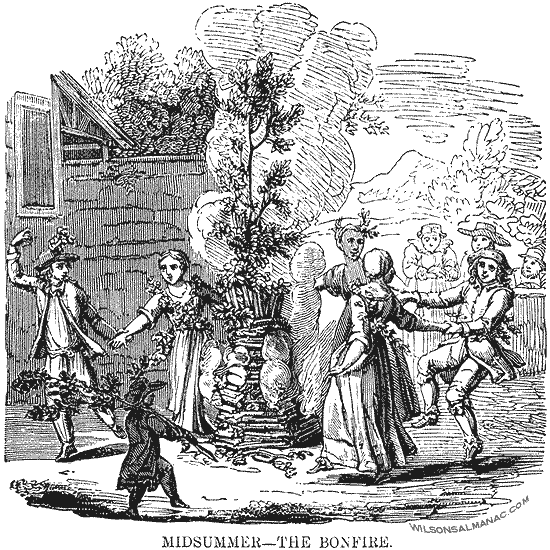June 23

The Scandinavians never pass up a chance for a good bonfire. Midsummer Night, or St. John’s Eve as it’s sometimes called in Denmark and Norway, is the perfect occasion. The holiday has little to do with St. John the Baptist, other than falling just before his saint day. In the 10th century Baltic and Scandinavian countries replaced the traditional names of Midsummer with allusions to the feast of St. John the Baptist, which fell on June 24.
In fact the tradition long pre-dates Christianity’s entry into Scandinavia. Midsummer was originally a tribute to the pagan sun god, and the bonfire represented defeat over darkness.
In Scandinavia, darkness hovers over the landscape for much of the year. On Midsummer Night however, it can stay light until midnight; in parts of Norway it can stay light for weeks at a time in late June, hence the name Land of the Midnight Sun.
For hundreds of years Midsummer Eve torch processions were common. Other rites centered around nature. Midsummer was viewed as an auspicious date for fertility. Farmers prayed for a bountiful harvest while maidens collected special herbs and plants, including St. John’s wort.
I must gather the mystic St. John’s wort tonight-
The wonderful herb, whose leaf will decide
If the coming year shall make me a bride…— “The St John’s Wort”, old German poem
In some towns, villagers would light a straw-covered wheel afire and roll it down a hill to be extinguished in the river. Across Poland and the Baltic, maidens would toss herbs into the fire to protect them from evil spirits in the year to come while young men would jump over fires to display their bravado.
Today the holiday is a time for community to come together around the bonfire and sing patriotic songs such as “Vi elsker vort land”, also known as Midsommervisen.
We love our land
Our midsummer most
When each cloud over the field sends a blessing
When the flowers are in bloom
And the cattle drags the plough
Giving gifts to laborious hands…
…Every woman, every man can
Find an example of love for life!
Let the times grow old, let the colors fade
We will however draw a memory in our hearts
From the North so rich in legends
A glory shines across the world…
To this day Danes continue to burn a straw witch effigy atop a bonfire on Midsummer Eve, a tradition borrowed from their German neighbors in the late 19th century. The witch effigy represents evil spirits, but to some the throwback eerily recalls the Danish witch burnings of the 1600s.
Other names for Midsummer Day and Eve:
Denmark: Sankt Hans aften (Hans is the diminutive of Johannes or John.)
Norway: Jonsok
Poland: Sobotka, Swietojanska, Wianki
Eastern Poland/ Ukraine: Kupalnocka, Kupala
Russia: Ivan Kupala
